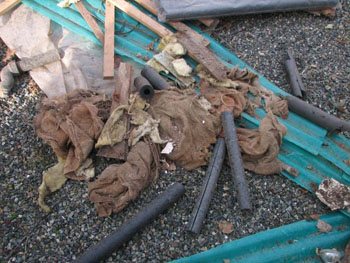“The first impression for a visitor arriving in a town is often formed by their view from a train carriage, and it is a disgrace that view is so often a degraded and dirty one that suggests a lack of care or pride in the area.”—Bill Bryson

How many times have you ridden on a train where railway property litter is just part of the scenery? I can’t think of a train trip when that wasn’t the case. Especially entering and emerging city rail stations, I’ve seen the strangest combination of things strewn—car seats, discarded wheel-less strollers, open-for-business signs, crumpled venetian blinds, things I haven’t been able to identify, hair-dryers, wigs. And everything plastic known to Man has just “blown” over the embankment.
As it turns out, this is also a serious pet peeve of Bill Bryson, current president of Campaign to Protect Rural England. (He doesn’t know it, but Bill also has the distinction of being one of my favorite Laugh Out Loud armchair-travel writer-humorists.*)
“This generation of people has a duty to pass the countryside on in as good a condition as we can.”
“In one of the most beautiful countries in the world,” (Bill, is it ok to call you Bill?) says “I just can’t understand how someone could open up a car window and toss out an empty pizza box.” That is something that has baffled so many of us over many a decade.
Since 1926 CPRE has been “campaigning for the beauty, tranquility and diversity of the countryside.” It is spearheading a movement to use a little enforced law requiring rail companies and public highway agencies to keep their properties clear of litter and rubbish. If written requests to agencies go unheeded, then anyone in the public can use a legal mechanism and file a Litter Abatement Order to enforce the law. Introduced by the Environmental Protection Act of 1990, this also applies to local councils, schools, colleges, hospitals, port authorities and airports. If you live in England, CPRE has instructions for you.
There are many conservation and landscape preservation issues CPRE addresses—over and above preserving hedgerows, championing for forests, deterring roadside advertising, sprawl and traffic, fly-tipping (sneaky dumping on the fly). Explore the CPRE website http://www.cpre.org.uk/home and their publication library http://www.cpre.org.uk/library.
On the right sidebar here at Garden Club Salon, see the “Blogroll” if you’d like to link to similar organizations in the U.S.—Keep America Beautiful, Scenic America, The Cultural Landscape Foundation, The Trust for Public Land. Use your favorite search engine to locate those U.S. states that have their own organizations dedicated to landscape protection.
*Bill Bryson was born in Iowa in 1951 but has spent most of his professional life living in England when he isn’t traveling. Among his many books are A Walk in the Woods: Rediscovering America on the Appalachian Trail, Notes from a Small Island, Down Under, A Short History of Nearly Everything, Made in America.
Thanks Bill, and thanks to all our friends at CPRE.
Nancy R. Peck
Read Full Post »











